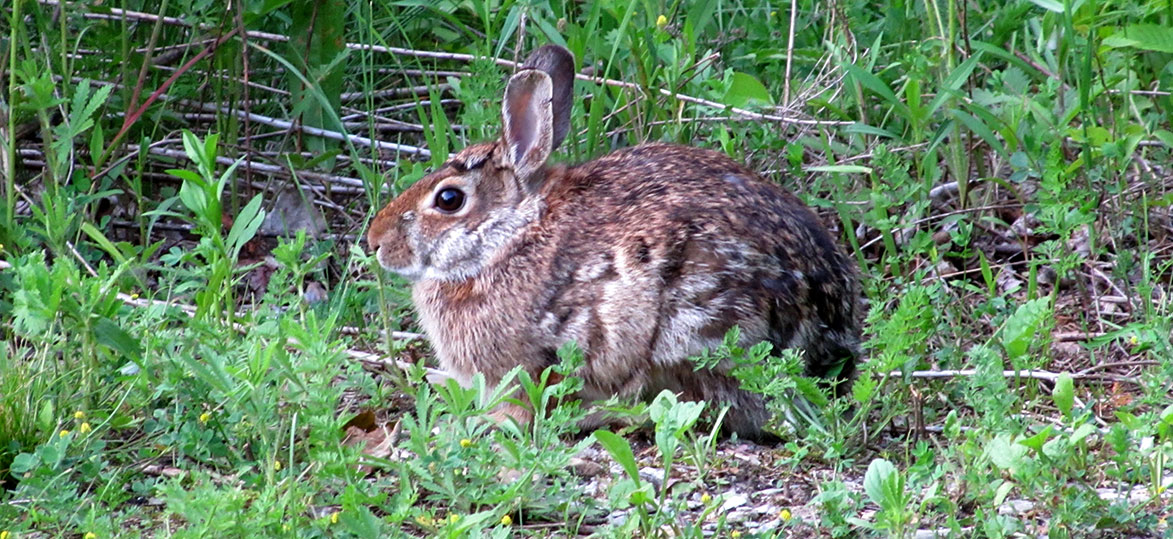
Historically, Vermont was home to two species of cottontail rabbit. They look similar and are almost impossible to tell apart in the field. New England cottontail rabbits are a native species that have resided in this state since pre-colonial times. Today, New England cottontails are extremely rare and, if present at all in Vermont, are confined to the most southerly part of the state.
Eastern cottontail rabbits (Sylvilagus floridanus) occur throughout the United States, but are not native to Vermont. They were introduced to New England in the late 1800s and are most common in southern regions of the state.
Habitat
Eastern cottontail habitat is found in valley farmland regions where fields and pastures are interspersed with hedgerows and low, dense brush. Winter is the most difficult time of year for rabbits.
In Vermont, snow cover limits the distribution and densities of the cottontail population. Because they are poorly camouflaged in snow, winter cover needs are acute for cottontails. They depend on low growing woody vegetation for food as well as for escape and thermal cover.
Cottontails will select areas of better cover over areas with abundant food if both are not found together. Rabbits have two different cover requirements: feeding cover and resting/escape cover. Dense vegetation can provide adequate summer cover, but in order for the rabbit to survive the Vermont winters, dense woody vegetation such as that found in old fields is critical.
The average home range size for Eastern cottontail rabbits is ten acres, although in high quality habitat it may be smaller. Cottontails tend to live in the same home area throughout their life, although they may range in only a smaller portion of it in winter when cover availability is lowest. Home ranges of rabbits tend to overlap, particularly in the best habitat.
Eastern cottontails are active day and night year-round. They spend their days resting on "form," or small, scratched out depressions in clumps of grass or under brush piles. During the night or during periods of heavy snow, cottontails may use underground dens of woodchucks as temporary shelter. Cottontails are solitary animals, and will meet other cottontails only briefly to mate.
Reproduction
The Eastern cottontail is a prolific breeder and mates from early spring through August. After mating, the female digs a depression about a foot into the ground and lines the nest with dry grass and a layer of fur she pulls from her body.
A litter of four to six young is born after a gestation period of 30 days. The young rabbits are blind, naked, and helpless, but grow and develop quickly. The mother will leave the young in the nest, nursing them only at dawn and dusk.
At three to five weeks of age, they are weaned and then left on their own. The female raises five to seven litters a year, but a high juvenile mortality rate offsets this reproduction rate.
Diet
Eastern cottontails are herbivores and eat many kinds of herbaceous plants, such as clovers, grasses, dandelions, and plantain. They also enjoy garden crops, such as green beans, peas, lettuce, and cabbage.
During winter when these food items are scarce, cottontails eat woody plant items, such as stems and buds of species like blackberry, raspberry, sumac, apple, and wild black cherry.
Management
Although cottontail populations fluctuate widely from place to place and from year to year, healthy populations can usually be maintained as long as there is suitable habitat. The Eastern cottontail is a species associated with old fields and edge-type habitat, thus the interspersion of woody vegetation with field in agriculture areas provides the best habitat.
Maintaining and improving hedgerows is an important management practice for this species. Hedgerows should contain dense woody vegetation three-to six-feet high and at least 20 feet wide. Mowing adjacent to hedgerows further enhances the habitat.
Old fields reverting back to forest also provide the critical cover requirements of cottontails. In the Champlain Valley, brushy areas of gray dogwood, prickly ash, red cedar and low-growing juniper near mowed meadows of grasses and legumes provide optimal conditions for eastern cottontails. Pastures containing red cedar and low growing juniper provide excellent habitat, if they are not heavily grazed.
All seasonal and life-cycle needs of the cottontail should be available within a ten-acre area. Two-to seven-and a-half acres (20-75%) of the managed area should be maintained as brushy cover. Reverting field or pasture should be kept in early successional stages by actively mowing, burning, or light grazing on half of the area every five to ten years.
Areas lacking early successional habitat can be enhanced with brush piles, or log or stump piles. Piles should be three to seven feet high and 13 to 20 feet in diameter. Place them adjacent to edges of fields, pastures, and wood lots, spaced 50 to 100 feet apart. Brush piles will break down in three to five years, so one-third to one-fourth of them should be replaced annually.
The remaining acreage should be composed of hay or cropland and/or deciduous forest. The spatial arrangement of woody vegetation and herbaceous vegetation is an important consideration when managing rabbit habitat. Brushy cover should be distributed throughout the area and not concentrated in one large block. Densities of one to three cottontails per two acres can be expected under optimum habitat conditions.
Status
The highest cottontail concentrations in Vermont can be found in the lower Connecticut River Valley and the southwestern portion of the state (Rutland and Bennington counties). They are less common in Addison, Chittenden, and Grand Isle counties.
